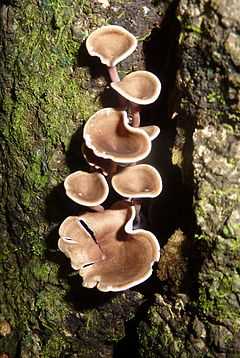Trogia
| Trogia | |
|---|---|
 | |
| Trogia cantharelloides, Panama | |
| Scientific classification | |
| Kingdom: | Fungi |
| Division: | Basidiomycota |
| Class: | Agaricomycetes |
| Order: | Agaricales |
| Family: | Marasmiaceae |
| Genus: | Trogia Fr. (1835) |
| Type species | |
| Trogia aplorutis (Mont.) Fr. (1835) | |
| Species | |
|
see text | |
Trogia is a genus of fungi in the family Marasmiaceae. It is named after a Swiss mycologist Jacob Gabriel Trog. The genus contains about 20 species that are widely distributed in tropical areas.
Taxonomy
The genus was first circumscribed by Elias Magnus Fries in 1835.[1] He set the type species as Trogia montagnei, a species that had been described by French mycologist Camille Montagne in 1834 as Cantharellus aplorutis.[2] The type has since been lost, and as a result, there has been some historical disagreement as to the boundaries of the genus. The British botanist Edred John Henry Corner emended the genus in 1966 to include 56 species.[3] Rolf Singer disagreed with this broad species concept in the fourth edition of his Agaricales in Modern Taxonomy (1986), and only included three species: T. cantharelloides, T. buccinalis, and T. montagnei. He considered most of the species included by Corner as better placed in genera like Hemimycena, Mycena, Gerronema, Hydropus, and Hymenogloea.[4] Corner later defended his species concept in a 1991 publication.[5][6] The 10th edition of the Dictionary of the Fungi (2008) estimates there are about 20 species in the genus.[7]
Description
The genus contains species with clitocyboid (gilled mushrooms that lack partial veils and feature white, yellowish, or pinkish spore prints) to omphalinoid (mushroom with a decurrent gill attachment, a cartilage-like stem, a broad or depressed cap surface and lacking a ring and volva) fruit body types. The fruit bodies are tough when dry, but can revive when moistened. They grow on rotting wood or woody material.[4]
Distribution
Species in the genus are found in tropical and subtropical areas.[4] Trogia cantharelloides (Mont.) Pat. is a widespread neotropical species,[8] recorded from Puerto Rico,[9] and Cuba among other places.
Uses
As a wood-rotting fungus genus, species of Trogia have enzymes that break down lignin, a complex polysaccharide that is largely responsible for giving wood its strength. Trogia buccinalis has been investigated for its ability to use these enzymes to break down common pollutant molecules such as anthracene, pentachlorophenol, and polyvinylchloride.[10]
Yunnan Sudden Death Syndrome
One species, Trogia venenata,[11] colloquially known as "little white" has been implicated in the deaths of around 400 people in Yunnan province, southwestern China. Appearing after local rainfall, the mushrooms contain toxic amino acids and seem to be cardiotoxic in susceptible people,[12] causing fatal arrhythmia. The amino acids are not used in proteins, and one is new to science, According to taxonomist Yang Zhuliang, Trogia was not previously thought to contain poisonous species. A team led by Chinese Center for Disease Control and Prevention epidemiologist Zeng Guang suggests that the element barium, present in local foods and contaminated water, may increase the toxicity of the Trogia mushroom.[13]
However, in December 2012 it was announced that Dr Xu Jianping (徐建平) has been collecting samples of trogia venenata in Yunnan for the past three years, and his research now shows that barium levels in the wild mushroom are no higher than those of common foods such as poultry and fish. Nonetheless, it appears the mushroom will still likely play a role. Since publication of the widely circulated 2010 Science article, no instances of Yunnan sudden death syndrome have been reported.
Species
- Trogia aplorutis
- Trogia buccinalis
- Trogia calyculus
- Trogia cantharelloides
- Trogia crinipelliformi
- Trogia cyanea
- Trogia holochlora
- Trogia icterina
- Trogia inaequalis
- Trogia infundibuliformis
- Trogia lilaceogrisea
- Trogia mellaea
- Trogia montagnea
- Trogia pleurotoides
- Trogia steriodes
- Trogia subviridis
- Trogia venenata
See also
References
- ↑ Fries EM. (1835). Corpus Florarum provincialium suecicae I. Floram Scanicam (in Latin). p. 336.
- ↑ Bélanger C. (1846). Voyage aux Indes-orientales, par le nord de l'Europe, les provinces du Caucase, la Géorgie, l'Arménie et la Perse pendant les années 1825–1829 (in French). p. 149.
- ↑ Corner EJH. (1966). A Monograph of Cantharelloid Fungi. Oxford, UK: Oxford University Press.
- ↑ 4.0 4.1 4.2 Singer R. (1986). The Agaricales in Modern Taxonomy (4th ed.). Königstein im Taunus: Koeltz Scientific Books. pp. 307–9. ISBN 3-87429-254-1.
- ↑ Corner, E.J.H. (1991). Trogia (Basidiomycetes). Gardens’ Bulletin, Singapore. Supplement 2:1–97
- ↑ Arun Kumar TK, Manimohan P. (2009). "Rediscovery of Trogea cyanea and a record of T. infundibuliformis (Marasmiaceae, Agaricales) from Kerala State, India". Mycotaxon 109: 429–36. doi:10.5248/109.429.
- ↑ Kirk PM, Cannon PF, Minter DW, Stalpers JA. (2008). Dictionary of the Fungi (10th ed.). Wallingford, UK: CAB International. p. 705. ISBN 978-0-85199-826-8.
- ↑ Halling RE, Mueller GM. (2002). Watling R, ed. Tropical Mycology, Volume 2. CAB International. p. 4. ISBN 0-85199-542-X.
- ↑ Baroni, Tim (1998). "Trogia cantharelloides (Mont.) Pat.". Neotropical Basidiomycetes. SUNY Cortland. Retrieved 14 July 2010.
- ↑ Martins-Franchetti SM, Egerton TA, White JR. (2010). "Morphological changes in poly(caprolactone)/poly(vinyl chloride) blends caused by biodegradation". Journal of Polymers and the Environment 18 (1): 79–83. doi:10.1007/s10924-009-0158-3.
- ↑ Zhou, Z. Y.; Shi, G. Q.; Fontaine, R.; Wei, K.; Feng, T.; Wang, F.; Wang, G. Q.; Qu, Y.; Li, Z. H.; Dong, Z. J.; Zhu, H. J.; Yang, Z. L.; Zeng, G.; Liu, J. K. (2012). "Evidence for the Natural Toxins from the Mushroom Trogia venenata as a Cause of Sudden Unexpected Death in Yunnan Province, China". Angewandte Chemie International Edition 51 (10): 2368–2370. doi:10.1002/anie.201106502.
- ↑ "Rare mushroom blamed for mystery deaths in China". BBC news. BBC. 14 July 2010. Retrieved 2012-10-28.
- ↑ Stone R. (2010). "Epidemiology. Will a midsummer's nightmare return?". Science 329 (5988): 132–4. Bibcode:2010Sci...329..132S. doi:10.1126/science.329.5988.132. PMID 20616244.
External links
- Trogia in Index Fungorum.
- Trogia in MycoBank.